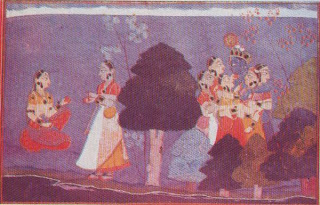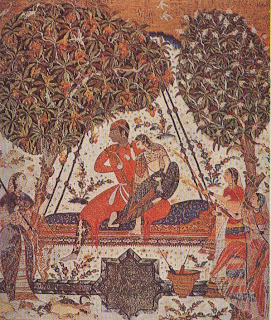 The
simplicity of colour and stylised form, the austerity and, above all, the
three-quarters profile of the face with angular nose, peculiar bulging of the
eyes and the pupils appearing in the centre even in the profile of the eye, one
of the eyes appearing outside the contour of the face, a projection of the
chin, and certain other features of anatomy, point to the development of the
Western Indian Gujarati school from the earlier Rashtrakuta tradition as found
at Ellora. It is interesting to compare the beginnings of this type of
representation of figure at Ellora, but the lapse of centuries has created
naturally a highly stylised mode in these later book paintings. The calligraphy
of the letters, though artistic, is austere, compared to Persian calligraphy in
manuscripts which, like the Chinese, gives a distinction to illuminated
manuscripts, and while the illustrations in the Persian books blend with the
calligraphy, the pictures tend to stand apart in the Gujarati texts.
The
simplicity of colour and stylised form, the austerity and, above all, the
three-quarters profile of the face with angular nose, peculiar bulging of the
eyes and the pupils appearing in the centre even in the profile of the eye, one
of the eyes appearing outside the contour of the face, a projection of the
chin, and certain other features of anatomy, point to the development of the
Western Indian Gujarati school from the earlier Rashtrakuta tradition as found
at Ellora. It is interesting to compare the beginnings of this type of
representation of figure at Ellora, but the lapse of centuries has created
naturally a highly stylised mode in these later book paintings. The calligraphy
of the letters, though artistic, is austere, compared to Persian calligraphy in
manuscripts which, like the Chinese, gives a distinction to illuminated
manuscripts, and while the illustrations in the Persian books blend with the
calligraphy, the pictures tend to stand apart in the Gujarati texts.
The
tradition of murals has been strongest in India, and the book illustration,
however well executed, still stands out as something different from the Persian
where it is an integral part of the manuscript and the pictures drawn are
homogeneous with the text. In India, illustrations on board, canvas and wall
have all had a common tradition, and if miniature paintings were introduced in
books, they look as if they were taken out reduced in size from the wall and
put alongside the text. Nevertheless, since paintings of a period beyond the
Rashtrakuta are lost or have not yet been found north of the Deccan, except the
stylised murals of the thirteenth century A.D., in the temple of Vishnu at
Madanpur, in the Lalitpur district of Uttar Pradesh, the Jain illustrated
manuscripts like the Kalpasutra, the Siddahemalaghuvritti, the
Kumarapalacharita and the Kalakacharyakatha, the earliest ones on palm-leaf and
the rest on paper, along with similar Pala manuscripts of eastern India, happen
to be almost the only examples of paintings earlier than the miniatures
contemporaneous with those of the Mughal school that come later.
The
western Indian illustrated palm-leaf manuscripts, the earliest of which date
from the eleventh century, continued for a few centuries, while rich and
colourful paper manuscripts with gold and silver lettering and decoration of
paintings became more varied, and there are texts like the Vasantavilasa, the
Balagopalastuti, the Salibhadracharita and others.
 The
simplicity of colour and stylised form, the austerity and, above all, the
three-quarters profile of the face with angular nose, peculiar bulging of the
eyes and the pupils appearing in the centre even in the profile of the eye, one
of the eyes appearing outside the contour of the face, a projection of the
chin, and certain other features of anatomy, point to the development of the
Western Indian Gujarati school from the earlier Rashtrakuta tradition as found
at Ellora. It is interesting to compare the beginnings of this type of
representation of figure at Ellora, but the lapse of centuries has created
naturally a highly stylised mode in these later book paintings. The calligraphy
of the letters, though artistic, is austere, compared to Persian calligraphy in
manuscripts which, like the Chinese, gives a distinction to illuminated
manuscripts, and while the illustrations in the Persian books blend with the
calligraphy, the pictures tend to stand apart in the Gujarati texts.
The
simplicity of colour and stylised form, the austerity and, above all, the
three-quarters profile of the face with angular nose, peculiar bulging of the
eyes and the pupils appearing in the centre even in the profile of the eye, one
of the eyes appearing outside the contour of the face, a projection of the
chin, and certain other features of anatomy, point to the development of the
Western Indian Gujarati school from the earlier Rashtrakuta tradition as found
at Ellora. It is interesting to compare the beginnings of this type of
representation of figure at Ellora, but the lapse of centuries has created
naturally a highly stylised mode in these later book paintings. The calligraphy
of the letters, though artistic, is austere, compared to Persian calligraphy in
manuscripts which, like the Chinese, gives a distinction to illuminated
manuscripts, and while the illustrations in the Persian books blend with the
calligraphy, the pictures tend to stand apart in the Gujarati texts.
These
pictures are distinctive in that the artists were inspired by a religious
fervour, a spirit of dedication and the thought of a theme in terms of its
nobility and universal appeal, rather than the appeal for the individual and
the sophisticated, and the delicate delineation of earthly power in all its
splendour, as in the case of the paintings at the Mughal court.
Probably
to a greater extent in these paintings than even in the later
religion-inspired, unsophisticated, tradition loving Rajasthani art, there is
an asceticism portrayed by the artist. This is no wonder, as Jainism, which had
its greatest stronghold in western India, could not have failed to impress the
mind of the painter, especially with austere themes like the lives of the
Tirthankaras, which are imbued with this asceticism. It is indeed interesting
to compare these paintings with somewhat later murals from Tirupparuttikunram
where the same spirit is observed to a great extent. Nevertheless, the life
around has had a profound impact on the painter who has brought out a complete
picture of the culture of the .period in all its grandeur with every detail of
dress and ornamentation, architecture and life portrayed. In these paintings,
the text almost makes up the border on either side, while the principal place
is given to the illustration where it occurs, and vermilion predominates, with
white and black liberally standing out in lines and curves composing contours
drawn on it. This is a distinct deterioration from the earlier classical style
and presents a highly folk-ridden or prakrita type.
Writer Name: C. Sivaramamurti
Subscribe to:
Post Comments (Atom)













0 Response to "Medieval Western"
Post a Comment